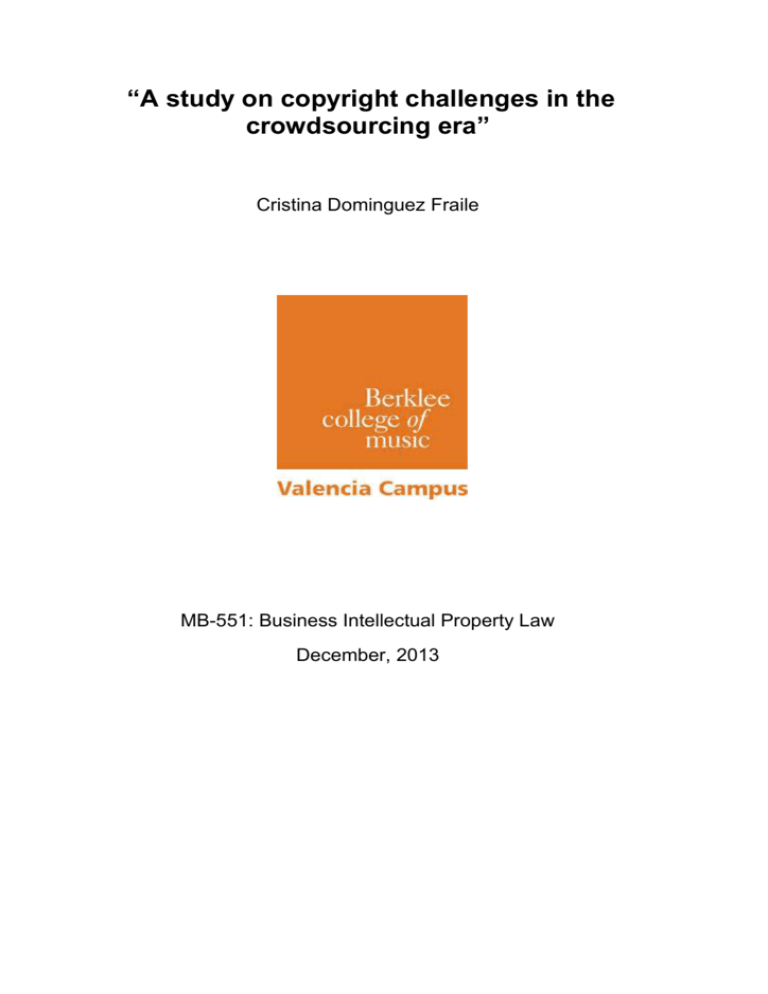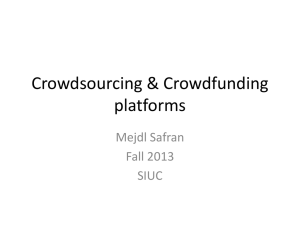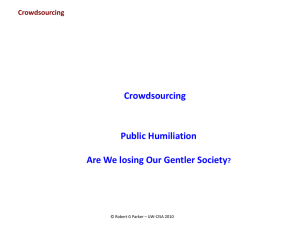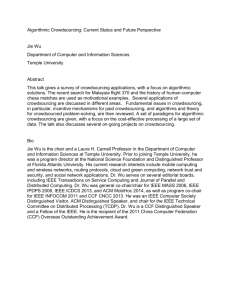43 - Copyrait
advertisement

“A study on copyright challenges in the crowdsourcing era” Cristina Dominguez Fraile MB-551: Business Intellectual Property Law December, 2013 1. What is crowdsourcing? Crowdsourcing is challenging the traditional state of the music industry and has gained substantial popularity and visibility around the world in recent years. With such a sudden rise in the practice of this model characterized by the participation of a large pool of individuals, it appears pertinent to analyze the legal challenges affecting the different parties involved, paying close attention to projects involving creative endeavors and copyright ownership in jointly developed works. As defined by Crowdsourcing LLC (2013) crowdsourcing is: “the act of outsourcing tasks, traditionally performed by an employee or contractor, to a large group of people or community (a crowd), through an open invite (call).” This practice is usually facilitated by online communities or platforms whose members share skills or interests, enabling individuals to co-create, collaborate, innovate, evaluate or fund a project in exchange for both intrinsic and extrinsic rewards, and differentiates from outsourcing in the fact that the work is not performed by a specific group or corporation but by an undefined public. 2. Crowdsourcing categories and platform analysis Crowdsourcing efforts can be directed towards multiple and diverse goals, such as business innovation, product development, funding, compilation of knowledge for collective resources, co-creation of creative works or even travelling. As such, this model can be subdivided in different overlapping categories with various legal models depending on the nature of the project and its contributions. 2.1 Crowdlabor: Connects companies and individuals with a virtual workforce available on demand to jointly collaborate on the fulfillment of a project or to conduct specific microtasking jobs such as translations, design, or content production. (Crowdsourcing, 2013) One of the most representative platforms, Fiverr, labels itself as “the world largest marketplace”, and allows its members to buy and share various services called “gigs” starting at $5. (Fiverr, 2013) The common practice in such platform is that creators waive all the rights associated with their creations or contributions to the buyer or the platform, and are economically compensated for their work. This means that the authors of creative works delivered though such platforms, like a song on demand or a company logo, assign all the rights associated with copyright ownership, videlicet reproduction, preparation of derivative works, distribution, public performance and public display. (Legal Information Institute, 2013) For example, an analysis of Fiverr’s terms of service reveals that “Buyers are granted all rights for the delivered work, unless otherwise specified by the seller in the Gig description” (Fiverr, 2013), allowing for some flexibility to adjust to the specific needs to each buyer and seller. Crowdflower, specialized in outsourcing micro tasks of large company projects to a large pool of contributors, assigns all rights to the platform itself, specifically: “If you are a Contributor, CrowdFlower, and not you, has proprietary rights in any work you produce as part of completing any task. By accepting the terms of this Agreement you agree to transfer possession, ownership, and title to your work to us.” (Crowdflower, 2013) Ultimately it is important to consider that Crowdlabor’s contributors are treated like independent contractors and not employees, which is a controversial subject of recent debates, and has several implications, i.e., companies have no need to comply with the Fair Labor Standards such as minimum wage or Social Security, and contractors are independently responsible for complying with tax requirements. (U.S. Small Business Administration, 2013) 2.2 Crowdfunding: As one of the most popular crowdsourcing alternatives within the music industry, Crowdfunding’s aim is to raise capital from micro donations to finance projects and initiatives, frequently in exchange for exclusive rewards, revenue or equity. (Crowdsourcing, 2013) Kickstarter, the largest funding platform for creative endeavors has helped to bring together creators and backers in order fund over 53,000 creative projects since its launch in 2009. (Kickstarter, 2013) Crowdfunding has had a vast impact on the music industry in an era characterized by the decline in album sales and the popularization of “do-it-yourself” models. In this scenario, several industry-related platforms have been developed to help artists fund their records, tours and projects while engaging their audience, such as Artist Share, Sell a Band, Pledge Music or My Major Company. These technologies are changing the practices of the industry and opening new opportunities for emerging artist, empowering them to fund their projects and eliminating the middlemen: record labels, distribution networks, agents, promoters, etc. As these initiatives only involve the contribution of financial resources from the backers, creators retain complete ownership of their creative works, with the platform commissioning a percentage on the amount raised. 2.3 Distributed knowledge: Distributed knowledge focuses on the development of information resources, crowdsourcing the collection, sharing or dissemination of knowledge. (Crowdsourcing, 2013) As crowd contributions are typically embodied in a large compilation of information used to shed light on social issues such as medical research or for educational purposes, individuals typically license their work to the crowdsourcing platform through an open license, supporting its free distribution and access. Wikipedia, the popular collaboratively edited online encyclopedia, requires from authors that wish to include their contributions a dual license from: Creative Commons Attribution-ShareAlike 3.0 Unported License (“CC BY-SA”): Creative Common licenses are based on copyright law, but aim to make copyright more flexible by allowing licensors to “grant copyright permissions to their creative work” (Creative Commons, 2013) In Wikipedia’s specific case, users are free to both create and adapt the preexisting articles under the following required terms: Attribution (authorship recognition is compulsory) and ShareAlike (modified works should be made available under the same license.) (Creative Commons, 2013) GNU Free Documentation License: worldwide, royalty free license for textual works. (GNU, 2008) Wikipedia contributors are required to license their original articles and corrections under a free and open license, granting permission for all users to reproduce, distribute and publicly display the content freely. More flexible copyright systems like Creative Commons are one of the available alternatives to overcome copyright ownership challenges present in online collective works, allowing platforms to use the content freely, reducing transaction costs. 2.4 Open innovation: Open innovation is characterized by the use of the crowd as an external source of innovation to generate, develop and implement ideas or technologies. This model encourages practices such as software development, business model innovation or product design. (Crowdsourcing, 2013) These projects demand the analysis of vast amounts of both valuable and inadequate proposals derived from a large pool of users, and it can be complicated to spot which people contributed enough to be considered authors and if so, in which proportion. Platforms like Idea Bounty act as intermediaries between supply and demand of ideas, and solve this problem by allowing clients to select and buy the ideas that best fit their needs and that will be implemented. Once an idea is selected, both parties receive a copyright assignment agreement in which the creator agrees to assign all intellectual property rights and interest in the Idea to the Client, who becomes the sole owner in exchange for a pre-established reward. (Idea Bounty, 2013) An alternative to copyright ownership assignment is, again, the use of open content licenses. This is the alternative chosen by the free and open source software Linux, which receives contributions from thousands of developers and programmers. Users license their contributions to the Linux Foundation through a Creative Commons Attribution 3.0 License, which allows other users to use, share and modify the software. Linux’ Terms of Service section specifies: “visitors to this website agree to grant a non-exclusive, irrevocable, royalty-free license to the rest of the world for their submissions to the Linux Foundation” (Linux Foundation, 2012) 2.5 Crowd creativity: Exploitation of creative talent pools to access, develop or jointly create artistic content tapping fields such as photography, advertising, video production, graphic design or music. Crowd creativity allows artists to generate more ambitious works while lowering the production costs. (Crowdsourcing, 2013) Many platforms in this area act like intermediaries between creators and clients, in this scenario, Audiodraft allows companies to set open contests for their audio needs in fields such as advertisement, TV, film or videogames. The selected artist receives an economical reward and handles a worldwide license for the buyer for all media, for a specified term to be determined between parties. (Audiodraft, 2013) Brands and companies are becoming increasingly involved in this projects. For example, Nokia used Audiodraft to launch a campaign to crowdsource the creation of a new tune for the company, offering a prize of $10,000 for the winner. (Audiodraft, 2011) Record Together connects songwriters that want to add instrumentation to their songs with session musicians. Each songwriter is the sole owner of his composition, and is offered the opportunity to buy the rights from the submitted recorded track that best fits his needs. Thus, upon purchase, the musician “irrevocably transfers all rights, ownership, intellectual property interest and legal title of the recording to the buyer. The Studio Musician/vendor will not use the recording in any further or derivative work.” (Record Together, 2013) An interesting example is Talent House, a platform for creative collaboration that connects emerging artists in all fields with other talents, established artists, brands and sponsors. (Talent House, 2013) While the platform’s About Us section specifies that artists retain ownership of their work, a deeper analysis of different available contests reveals that this is not always the case. Artists should take care when submitting their creations to crowdsourcing platforms and read the fine print of the contracts carefully as they may find themselves waiving all rights to their work without noticing. For instance, the terms for a former sponsorship contest for $10,000 specifies: “By entering the Contest, entrants irrevocably grant Sponsor, its subsidiaries, divisions, affiliates, designees, clients, sponsors, licensees, and advertising and promotional agencies, an unlimited, worldwide, perpetual, non-exclusive, royaltyfree, unconditional license and absolute right to edit, post, publish, store, copy, transmit, publicly display, and exhibit, the Work (in whole or in part) in connection with the Contest and/or the promotion of the Contest. Upon Sponsor's request, winners agree to sign any and all legal forms deemed necessary to license or assign all right, title and interest in and to the Work, including without limitation, all copyrights associated therewith, in exchange for the Prizes set forth above.” (Talent House, 2013) More stimulating than intermediary platforms are online projects that involve the co-creation of an artistic joint work, such as the Johnny Cash Project. Through this interactive webpage, each user can submit a drawing of a specific frame of Cash’s “Ain’t No Grave” video clip, creating a moving portrait that evolves with each submission. (The Johnny Cash Project, 2010) Each of these drawings is considered a contribution to a joint work, defined as “a work that is created by two or more people that intend their contributions to be merged into inseparable parts of a whole” (Lease & Wolfson, 2011) Typically, each author holds copyright rights on his specific contribution to a joint work, however, as the project organizer, Universal Music Group establishes itself as the exclusive owner of all the content provided, while authors are entitled to attribution rights and appear as creators in the credits. (Universal Music Group, 2010) Another remarkable project is Eric Whitacre’s Virtual Choir, a user-generated global choir comprising more than 5,903 singers that individually record and submit performances that are later synchronized in a video. In order for Virtual Choir to be able to synchronize all individual creations to a video, reproduce, distribute and publicly perform the project, users agree that all content provided is non-proprietary and can be used by the webpage at their discretion. (Eric Whitacre, 2013) 3. Legal challenges and recommendations for risk minimization The previous platform analysis reveals that there are several crowdsourcing models available that provide an instant and global access to talent, workforce or funding, fostering creativity and innovation at a reduced cost. Crowdsourcing can also exert a positive influence on consumer and audience engagement, as they feel more involved in the project, allowing for successful campaigns and initiatives. Nevertheless, it is important to be conscious of the legal implications that these efforts entail for both creators and buyers, and ensure that all parties involved enjoy adequate IP protection. Artists should be careful not to assign more rights that what they need, as they can easily lose control on creations that they planned to exploit in the future, since in many projects buyers become the owners of the submitted ideas or works. Each platform’s terms and conditions should be carefully analyzed to avoid misunderstandings, and proper research should be conducted to find the appropriated model for each creator’s interests and career. Artists should choose carefully between platforms that involve copyright assignment and models that only require a license, specifically paying attention to clauses related to exclusivity, revocability and term. As users may be concerned about intellectual property protection, some tools are available to protect innovators’ and creators’ ideas that are still in their early stages of development such as provisional patent applications or Creative Barcodes, which allow authors to place a unique barcode on their content that gives information on the granted permissions, allowing for a safer mechanism to share groundbreaking ideas. (Crowdsourcing, 2013) On the other hand, buyers should ensure that their contracts with content providers assign them the required intellectual property rights to use the contributions without falling into copyright infringement since most crowdsourcing authors are considered contractors and the initial ownership of IP rights lies in them. Because contributors are not employees, crowdsourcing projects do not fall into the work for hire category, unless otherwise specifically agreed in writing by both parties. This has several implications to consider: the license or transfer of rights should be properly cleared and creators are entitled to request the termination of copyright assignments after 35 years. To soften this situation, platforms should provide clear written terms of service, and define in advance the relationship between the different parties involved, specifying what buyers are entitled to do with users’ names and likenesses and their rights over the submitted intellectual creations in order to avoid potential claims regarding data protection or copyright infringement. (Lieberstein, Tucker & Yankovsky, 2012) Additionally, buyers should ensure that the acquired creations do not contain IP rights that belong to a third party. As contributions come from a large pool of users, it is likely that some submissions will contain infringing or unauthorized material protected by other parties’ copyright, trademark law or image rights protection. To protect buyers and themselves, platforms typically require content providers to warranty that they are the sole owners of their contributions, and terminate the account of infringing users. However, this may not be absolutely effective and claims for copyright infringement are a risk that buyers hold, as infringing users may lack the resources to indemnify plaintiffs, and the liability would fall on the buyer. (Lieberstein, Tucker & Yankovsky, 2012) Another potential legal pitfall that buyers may face is related to platforms in which the potential buyer is provided with many ideas or works from which a winner is selected. Unsuccessful authors may sue the company for copyright infringement if a similar idea to their contribution is selected and implemented. As a defense to any potential claim for copyright infringement, it would be advisable for these companies to maintain a record of the idea development to prove the individual process of creation. (Draper, 2013) Crowdsourcing platforms are here to stay, and can be of high value to both creators and idea-seekers, although it is highly recommendable to conduct a prior extensive research or legal consultation to increase awareness of the law affecting its practices, ensuring that both parties enjoy effective IP protection, evade its potential legal pitfalls, and extract the maximum from the presented new opportunities. 4. Bibliography Crowdsourcing (2013) “FAQ” ”, accessed December 10, 2013, http://www.crowdsourcing.org/faq#anchor3 Crowdsourcing (2013), “The five crowdsourcing categories ranked: popularity in social media”, accessed December 10, 2013, http://www.crowdsourcing.org/editorial/the-five-crowdsourcing-categories-rankedpopularity-in-social-media/10176 Fiverr (2013), “Terms of service”, accessed December 10, 2013, http://fiverr.com/terms_of_service Legal Information Institute (2013), “Exclusive rights in copyrighted works”, accessed December 10, 2013, http://www.law.cornell.edu/uscode/text/17/106) Crowdflower (2013), “CrowdFlower Master Terms of Service”, accessed December 11, 2013, http://crowdflower.com/legal U.S. Small Business Administration (2013) “Hire a Contractor or an Employee?”, accessed December 11, 2013, http://www.sba.gov/content/hire-contractor-oremployee Kickstarter (2013), “What is Kickstarter”, accessed December 11, 2013, http://www.kickstarter.com/hello?ref=nav Creative Commons (2013), “About the Licenses”, accessed December 11, 2013, http://creativecommons.org/licenses/ Creative Commons (2013), “Attribution-ShareAlike 3.0 Unported”, accessed December 11, 2013, http://creativecommons.org/licenses/by-sa/3.0/ Gnu (2008), “GNU Free Documentation License”, accessed December 11, 2013, http://www.gnu.org/copyleft/fdl.html Idea Bounty (2013) “Assignment Agreement”, accessed December 15, 2013, http://www.ideabounty.com/license-agreement Linux Foundation (2012) “Terms of Service”, accessed December 15, 2013, http://www.linux.com/terms Audiodraft (2013), “How it works”, accessed December 17, 2013, https://www.audiodraft.com/how-it-works/ Audiodraft (2011) “Nokia Tune Remake”, accessed December 16, 2013, https://www.audiodraft.com/contests/123-Nokia-Tune-Remake Record Together (2013), accessed December 17, 2013, https://www.recordtogether.com Talent House (2013), “About us”, accessed December 17, 2013, http://blog.talenthouse.com/contact-us/about-us/?lang=en Talent House (2013) “Share your music, win $10,000 and a life changing trip to LA”, accessed December 17, 2013, http://www.talenthouse.com/live-your-dreamlos-angeles-music#description Lease, Matthew & Wolfson, Stephen (2011) “Look before you leap: legal pitfalls of crowdsourcing” University of North Texas, accessed December 17, 2013, https://www.ischool.utexas.edu/~ml/papers/wolfson-asist11.pdf The Johnny Cash Project (2010) “A Living Portrait of the Man in Black”, accessed December 17, 2013, http://www.thejohnnycashproject.com/#/about Universal Music Group (2010) “Web Site Terms and Conditions”, accessed December 17, 2013, http://privacypolicy.umusic.com/terms/ Eric Whitacre (2013) “Terms and Conditions”, accessed December 17, 2013, http://ericwhitacre.com/community/terms Crowdsourcing (2013) “Creative Barcode: addressing intellectual property protection issues around crowdfunding”, accessed December 17, 2013, http://www.crowdsourcing.org/editorial/addressing-intellectual-property-protectionissues-around-crowdfunding/24287 Lieberstein, Marc; Tucker, Ashford & Yankovsky, Andrea (2012) “Crowdsourcing: Understanding the Risks” New York State Bar Association, accessed December 17, 2012, http://www.kilpatricktownsend.com/~/media/Files/articles/2012/MLieberstein%20N YSBA.ashx Draper, Roberta (2013), “Crowdsourcing- a great concept but are you aware of the legal risks?”, accessed December 17, 2013, http://www.kingsleynapley.co.uk/news-and-events/blogs/technology-lawblog/crowdsourcing-a-great-concept-but-are-you-aware-of-the-legal-risks




